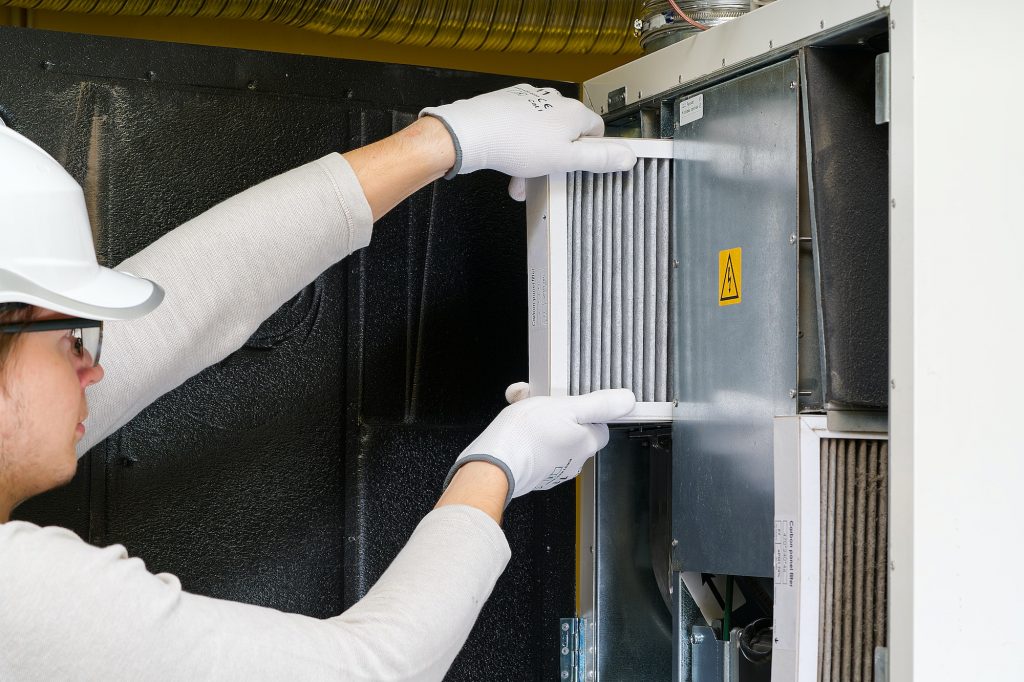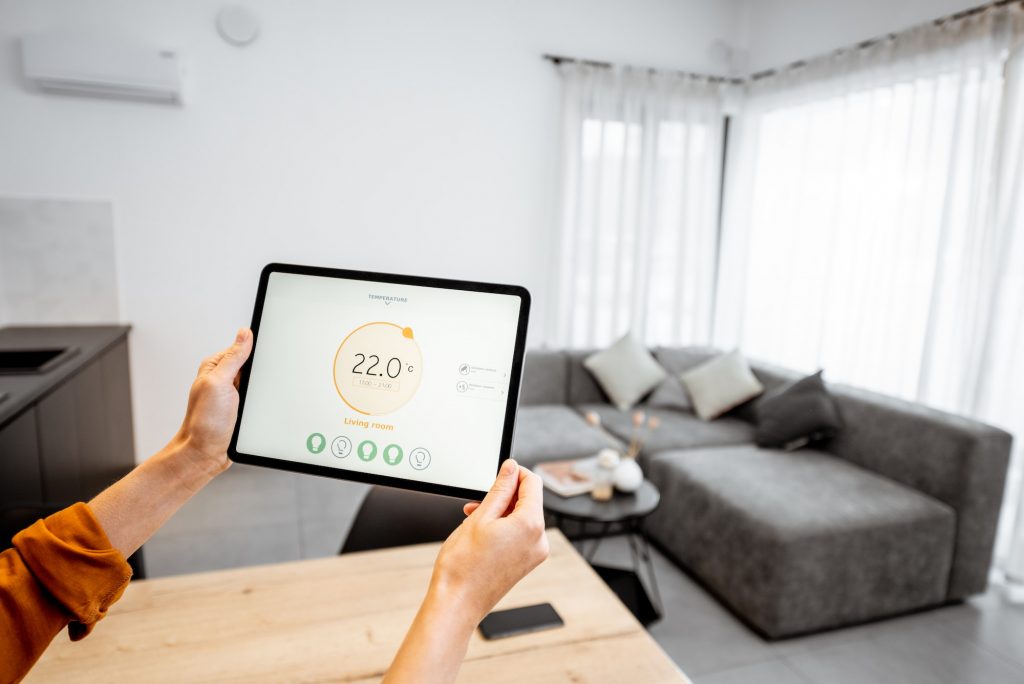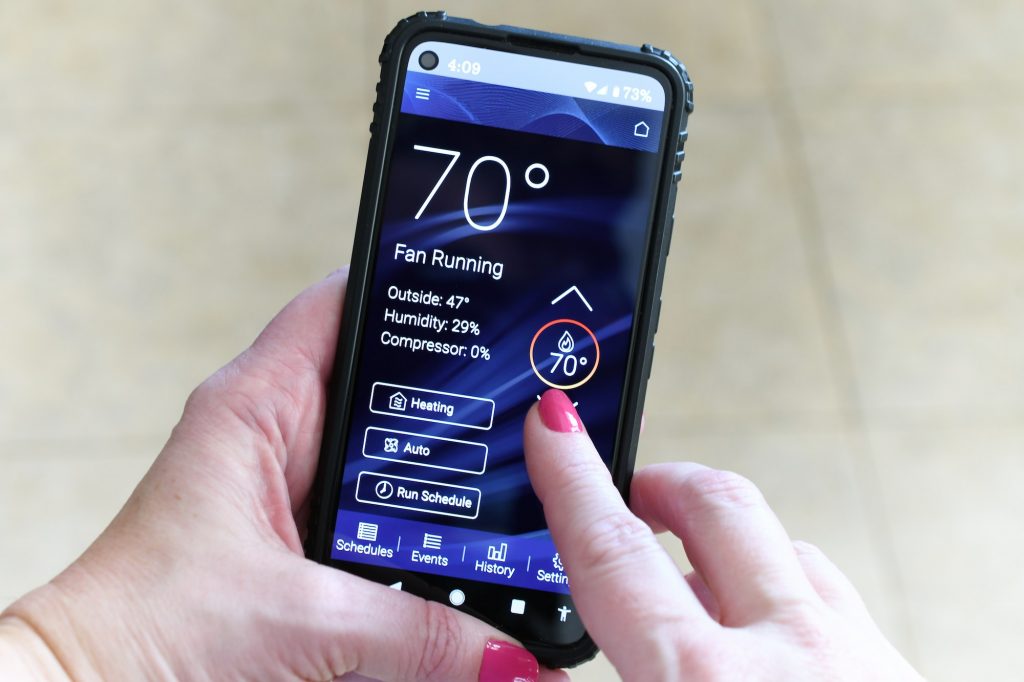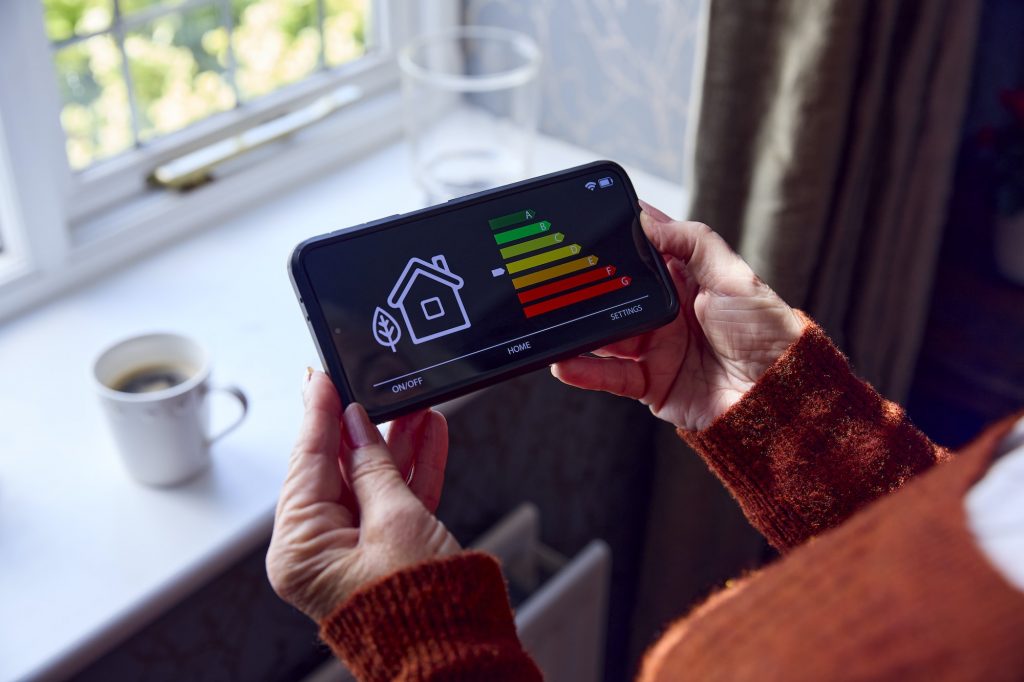In an era of rising energy costs and growing environmental awareness, homeowners are seeking ways to maximize efficiency and reduce their carbon footprint. Implementing smart heating solutions and utilizing tool hire for installations and upgrades can help transform homes into intelligent, sustainable, and comfortable living spaces.
As we enter the age of the smart home, advanced heating and cooling systems now feature built-in wifi connectivity, smart sensors, and integration with other smart devices. With programmable and self-learning thermostats, zonal control, and remote access via smartphone apps, heating equipment is becoming more energy-efficient, convenient and customizable than ever before.
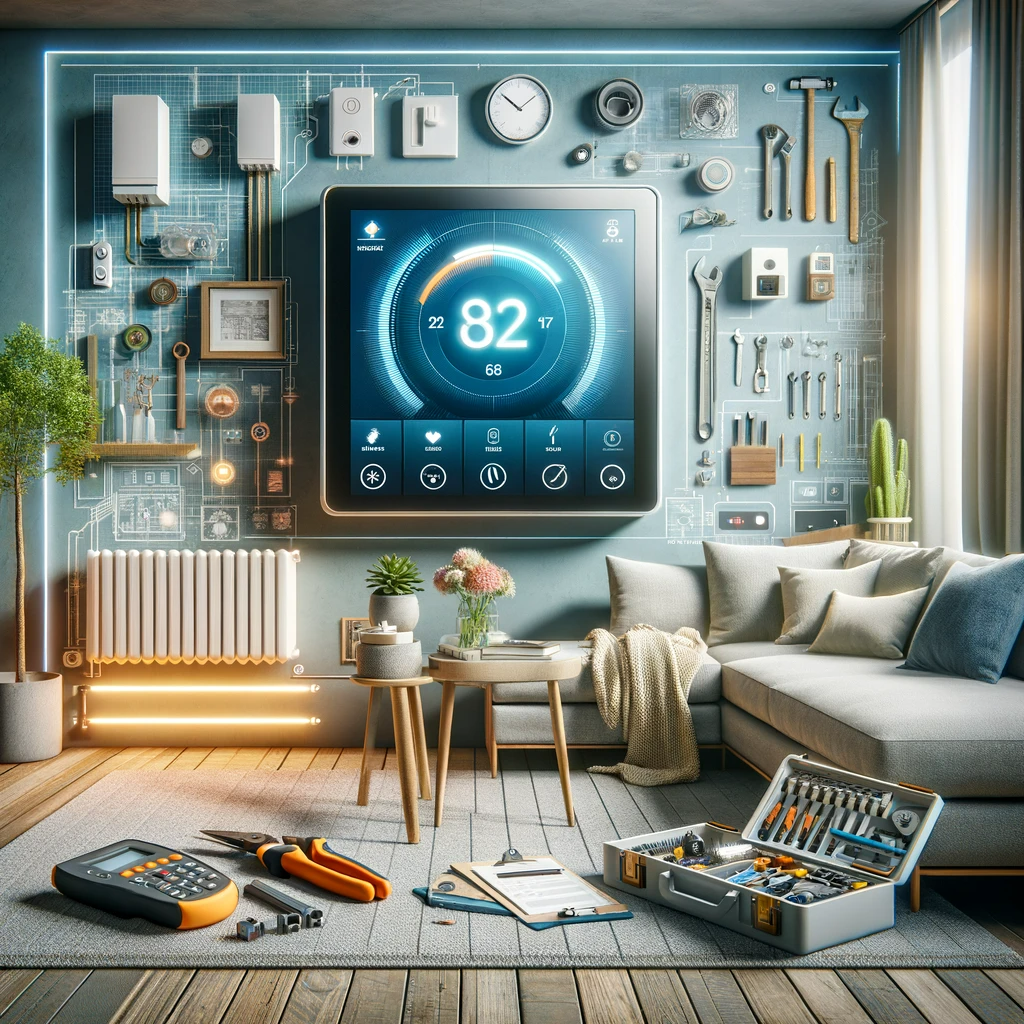
Meanwhile, with some basic DIY skills and the right equipment, homeowners can complete installations and upgrades themselves instead of hiring contractors. Tool hire provides cost-effective access to all the advanced tools needed for today’s smart home projects without having to invest in expensive equipment.
Read on to discover how embracing smart heating solutions and tool hire can help maximize the efficiency, sustainability and comfort of your home.
Understanding Smart Heating: The Future of Home Climate Control
Home heating systems have advanced considerably from the traditional gas- and oil-fired boilers and electric resistance heaters of the past. Modern smart heating solutions utilize innovative technologies like heat pumps, hybrid systems, zoned heating, and integrated home automation.
Heat Pumps
Heat pumps are one of the most energy and cost-efficient heating and cooling solutions available today. Unlike furnaces that burn fossil fuels to generate heat, heat pumps simply move existing heat between indoor and outdoor air. There are two main types:
- Air source heat pumps transfer heat between outdoor air and the home’s air supply. Energy-efficient compressors power the heat transfer process.
- Geothermal heat pumps use buried underground piping loops filled with water or antifreeze to transfer heat between the earth and the home.
With both types, advanced systems can provide both heating and air conditioning from a single unit.
Hybrid Heating Systems
Some homeowners are opting for hybrid heating systems that combine multiple technologies like heat pumps and high-efficiency gas furnaces. The different heat sources complement each other to maximize efficiency.
For example, a hybrid system may rely primarily on its heat pump but utilize a gas furnace during extremely cold weather when the heat pump’s output is reduced. Some hybrid systems even integrate renewable energy like solar water heating.
Zoned Heating Solutions
Traditional heating systems maintain a consistent temperature throughout an entire home. But with zoned heating solutions, different areas of a home can be heated to different temperatures as needed.
Zoned systems utilize multiple smart thermostats and dampers to control individual rooms. This maximizes comfort while avoiding wasting energy heating unused rooms.
Integration with Home Automation
The latest smart thermostats and heating systems can be integrated with whole-home automation and smart hubs like Alexa and Google Home. This allows for heating schedules, occupancy detection, voice commands, remote access via smartphone apps and more.
Exploring Home Efficiency: Beyond Just Energy Savings
Upgrading to modern high-efficiency heating equipment and embracing smart technology serves purposes beyond reducing energy consumption and costs. The efficiency and sustainability of a home encompasses more holistic goals:
Enhanced Comfort
Programmable and zoned heating solutions allow homeowners to customize temperatures in different rooms as desired. Smart sensors also enable systems to detect occupancy and adapt heating operations for optimal comfort.
Improved Air Quality
Advanced heating and cooling systems filter out airborne irritants like dust, mould spores and pet dander. Some feature air purification ionizers and UV lights to sanitize circulating air.
Responsible Resource Use
Smart technology empowers homeowners to reduce energy waste and rely more on renewable sources like geothermal and solar heating. This eases the strain on grids and non-renewable resources.
Reduced Environmental Impact
By cutting carbon emissions, the latest high-efficiency heating solutions help homeowners reduce their carbon footprint. Smart technology also enables convenient waste recycling.
Peace of Mind
Smart sensors provide real-time notifications regarding heating system operation and can even detect developing faults to prevent breakdowns. Remote access offers control and monitoring while away from home.
The Role of Tool Hire in Smart Home Installations
While smart heating systems and home automation offer enticing capabilities, the high equipment and installation costs can deter some homeowners. This is where utilizing tool hire can make all the difference.
Renting professional-grade tools provides cost-effective access to all the equipment needed for Do-It-Yourself installations. Homeowners can thereby avoid contractor markups and expensive one-off purchases.
Key Advantages of Tool Hire
- Cost Savings – No need to invest in tools that may only get infrequent future use
- Project Empowerment – Tackle installations yourself instead of hiring contractors
- Equipment Access – Utilize pro-grade tools not available at most retail stores
- Convenience -Easy online bookings and tool delivery direct to your site
Essential Tools for Smart Home Projects
Here are some go-to tool hire items that will equip you to take the DIY approach for smart home upgrades:
- Cordless drill drivers and impact drivers
- Electrical wiring tools – strippers, crimpers, testers
- Voltmeter
- Stud finder
- Laser Level
- Ladders
- Drywall lift
- Shop vac
- Power saws
- Pipe cutters and threading tools
- Soldering equipment
- Hand and power tools for minor plumbing and HVAC tasks
Heating System Installation: A DIY Approach
Ambitious homeowners willing to do some research and get their hands dirty can totally DIY the installation of smart heating systems if properly equipped through tool hire.
Typical equipment like heat pumps, furnaces and boilers involve some combination of the following tasks:
- Electrical wiring
- Connecting ductwork
- Mounting temperature sensors
- Linking with home automation hubs
- Minor plumbing for water or gas lines
- Cutting ventilation openings
- Pouring concrete pads for outdoor units
While specialized skills like refrigerant line connections are best left to HVAC pros, many installation steps can be managed DIY with some patience and the right tools. Be sure to research local building codes and get all necessary permits before proceeding.
Smart Home Technology: Integrating Advanced Systems
Beyond heating and cooling equipment, homeowners seeking to build high-tech smart homes require ways to integrate various connected systems and devices. Seamless automation and control hinge on robust central hubs.
Home Automation Hubs
Smart home platforms like Google Home and Amazon Alexa act as central hubs that allow various appliances, lighting systems, sensors, locks, cameras and entertainment devices to connect on a single network.
They provide both app and voice-based control of all integrated smart devices. New devices and capabilities get added all the time via skills and partnerships.
Advancements in Connectivity Protocols
Internet-connected smart home tech relies on wireless protocols like WiFi, Bluetooth, Z-Wave and Zigbee. As standards evolve to offer extended range, faster data rates, and mesh networking, device integration and automation improve.
For example, WiFi 6 and the new Matter protocol promise wider adoption across brands and easier smart home expansion. Support for multiple protocols in hubs improves backwards compatibility as standards advance.
The Promise of AI and Predictive Algorithms
Hubs powered by artificial intelligence and capable of machine learning can study home activity patterns and environmental factors to optimize automated heating, lighting and device operation intuitively over time – no programming required!
DIY Home Improvement: Empowering Homeowners
Constructing advanced smart homes packed with the latest technology can seem daunting for homeowners without professional electrical, HVAC and carpentry skills. This is why embracing the DIY approach and utilizing tool hire for equipment access is so empowering.
Developing Handyman Potential
Tackling installations and upgrades yourself allows you to learn useful new DIY skills that can then be applied to future projects. And thanks to YouTube and online forums, handymen today have access to more step-by-step guides and troubleshooting advice than ever before.
Customizing Your Smart Home Vision
Professional installers are focused on getting in and out efficiently. But homeowners taking the DIY route can take their time perfecting small custom details like neatly hiding wires and sensors or integrating smart vents with architectural moulding.
Ongoing Maintenance and Upgrades
Even long after your initial smart home project, you’ll be able to equip yourself to handle repairs, replacements and upgrades yourself as needed – no more waiting around for appointments!
Energy Saving Tips: Practical Strategies for Efficiency
While advanced heating and cooling technology offers clear efficiency advantages, homeowners must utilize smart systems effectively to maximize energy savings in daily operations.
Here are some key tips:
- Learn advanced programming features – Take time to master scheduling, occupancy modes, away settings and integration with other devices related to lighting and shade control.
- Leverage zonal control – Close vents and change target temperatures in unused rooms. Zone division allows shutting off unused areas.
- Use eco modes – Eco mode settings slightly relax temperature bounds to limit duty cycling which saves electricity.
- Adjust seasonal changeover – Optimize heat pump balance points and furnace thermostat headbands to limit auxiliary resistance heat.
- Compare rates and caps – Consider enrolled smart plans with hourly pricing, bill credits or usage caps from your utility. Sync schedules to cheaper night hours.
- Insulate effectively – Seal leaks and insulate attics, basements and ducts to reduce heating and cooling losses.
Programmable Thermostats: Maximizing Comfort and Savings
One of the simplest ways to make home heating smarter is to upgrade to an advanced programmable or learning thermostat. Modern connectivity and automation features can optimize both comfort and efficiency.
Here’s an overview of popular options:
- WiFi Thermostats – Adjust heating remotely and integrate with smart home platforms for expanded capabilities
- Voice Control – Use vocal commands to change setpoints or operation modes
- Smart Scheduling – Built intelligence leverages usage patterns to optimize heating schedules
- Geofencing and Occupancy Detection – Detect when residents leave home or enter specific rooms to automatically adjust HVAC settings for comfort and savings
- Weather Compensation – Self-adjust settings gradually based on local weather forecasts
- Zoning Capability – Separately control temperatures in different rooms
- Advanced Analytics – Review usage data like duty cycle times to identify efficiency opportunities
Importance of Regular Heating Maintenance
To sustain optimal efficiency and reliability over their typical 15-20-year lifespan, heating systems require annual maintenance to keep components functioning properly. Neglecting maintenance can negatively impact energy usage, indoor air quality and system longevity.
Here are key annual maintenance tasks DIY homeowners should master:
- Replace air filters to maintain airflow and prevent strain on blowers
- Clean air handler coils to preserve heat transfer efficiency
- Inspect gas connections to check for leaks lowering fuel efficiency
- Drain sediment from hot water boilers to allow efficient water heating
- Brush/vacuum heat exchanger fins to enable good air circulation
- Check duct sealings to limit conditioned air leaks
- Test carbon monoxide detectors to verify home safety
Cooling Solutions: Balancing Home Temperature
To achieve complete climate control while maximizing home efficiency, integrated heating and cooling solutions present the ideal option. Proper sizing along with smart technology allows systems to maintain a comfortable yet economical balance.
Heat Pumps Revisited
As outlined previously, air source and geothermal heat pumps can provide both heating and cooling from the same unit by simply reversing the refrigerant flow direction. This eliminates the need for separate furnaces and air conditioners.
Fans, Ventilation and Zoning
Strategically placed ceiling fans, whole-house fans and zoning of ductless mini-split heads can work alongside central heating and cooling to distribute temperatures evenly. Smart vents or dampers help direct conditioning only where needed.
Managing Humidity
Dehumidification is crucial for comfort during warm muggy periods. Heat pump systems dehumidify by running cooling modes even when temperatures are set to heat. Some feature extra reheat coils to prevent overcooling.
Smart Appliances: Revolutionizing Home Automation
Integrating internet-connected smart appliances allows them to participate within home automation systems and respond optimally based on conditions and usage patterns detected by an intelligence hub.
Here are some of the latest smart appliance capabilities:
- Enable voice control for convenient hands-free operation
- Receive status alerts regarding maintenance needs or operational issues
- Optimize run times to leverage electricity rate fluctuations and solar generation
- Regulate load sequencing to prevent circuit overload when multiple big loads run simultaneously
- Trigger actions in other devices like when the clothes dryer finishes a cycle
Achieving HVAC Efficiency: Tips and Tricks
Advanced heating and cooling equipment offers clear efficiency advantages, but homeowners can implement certain usage practices and design strategies to further improve the performance of HVAC systems.
Operational Tips for Efficiency Gains
- Close floor and wall vents in unused rooms
- Adjust the temperature setpoint a couple of degrees warmer/cooler
- Use smart ventilation instead of always using AC
- Check refrigerant charge if AC short cycles frequently
- Vacuum accessible evaporator coils occasionally
Design Modifications for Improved Efficiency
- Enclose ductwork running through unheated/uncooled spaces
- Add radiant barrier sheathing to attic spaces
- Insulate exterior-facing ducts, walls, ceilings and floors
- Caulk/weatherstrip around doors, windows and wiring penetrations
Home Automation Systems: Simplifying Life
As the number of internet-connected smart devices proliferates in modern households, standalone control of each product gives way to consolidated platforms and hubs that unite everything into a single intuitive interface.
Here’s an overview of the growing capabilities of home automation systems:
Device Integration
Hubs allow lighting, locks, cameras, sensors and appliances from various brands to interoperate, activated by custom scenes or automation rules.
Notifications
Get alerts about open doors/windows, finished laundry cycles or appliance errors so you can address issues promptly even while away.
Remote Access
Monitor and control devices from anywhere via smartphone apps for on-the-go convenience and peace of mind.
Voice Commands
Hands-free vocal interactions allow occupants to control settings, initiate playback, and operate devices through AI assistants.
Schedules and Scene Automation
Configure devices to activate based on time of day or triggers like sunrise/sunset. Define preset scenes like movie night.
Selecting the Right Installation Tools
Taking the DIY route for smart home upgrades requires having the proper tools for tasks like hanging flatscreens, wiring smart switches, securing wireless access points and more.
Here are seven essential categories of installation tools to have on hand:
Basic Hand Tools
This includes hammers, screwdrivers, wrenches, pliers, utility knives, tape measure, level, stud finder and pry bar.
Power Drills and Drivers
Cordless power drills/drivers and impact drivers feature variable speed motors and clutch control for driving screws and drilling holes in wood or drywall.
Sawing Tools
Jigsaws, circular saws, oscillating multi-tools and hand saws help cut walls, floors, cabinets and trim to accommodate wiring runs or new low-voltage openings.
Electrical Tooling
Wire strippers, cable cutters, terminal crimpers, coax compression tools and non-contact voltage testers are made for low-voltage cabling tasks.
Fasteners and Anchors
Stock various screws, toggle bolts, molly bolts, sleeve anchors, lead anchors and wall plugs for solidly mounting equipment.
Climbing Gear
Get a sturdy stepladder along with a small scaffold or work platform for tasks requiring ceiling access like recessing smart speakers or installing ceiling fans.
Safety Equipment
Don’t forget essential safety gear like work gloves, protective eyewear, dust masks and hard hats that reduce the risk of injury from falling debris.
Renewable Energy Sources: A Sustainable Choice
Seeking to reduce their carbon footprint, some tech-savvy homeowners are integrating renewable energy sources like solar and geothermal heat to supplement or even replace reliance on fossil fuels.
Solar Electric Panels
Photovoltaic (PV) panels convert sunlight directly into electricity that displaces grid power usage. Extra solar energy can even be sold back to the utility.
Solar Water Heating
Solar thermal panels absorb heat from sunlight to warm fluids circulating through pipes. This solar hot water helps meet domestic hot water needs and swimming pool heating.
Geothermal Heat Pumps
As outlined previously, geothermal systems use subsurface warmth made consistent year-round to provide extremely energy-efficient heating and cooling.
Wind Turbines
Small residential wind turbines can harness kinetic energy from the wind to generate supplemental electricity. Their practicality depends greatly on average wind speeds in the area.
Managing Energy Bills: Effective Strategies
Between climbing electricity rates and changing rate structures introducing new fees and dynamic pricing, homeowners must actively manage energy usage to contain rising costs.
Compare Electric Plans
Compare pricing and incentives across retail provider plans in deregulated markets to find the best effective rates. Consider month-to-month subscription plans allowing rate plan switching anytime rates shift.
Shift Usage to Cheaper Hours
In peak demand pricing plans like those from ComEd and ConEd, overnight hours offer far cheaper per kWh rates. Smart tech allows heating, charging and appliances to target these hours.
Take Advantage of Credits and Rebates
Utility efficiency programs issue generous rebates for upgrading to qualifying high-efficiency equipment featuring smart controls. Some even provide monthly bill credits for participating.
Size Systems Properly
Oversized cooling systems cycle too much wasting electricity. Properly sized variable capacity systems run at reduced output most of the time for efficiency.
Enhancing Home Comfort Through Smart Technology
Beyond efficiency gains, homeowners upgrade home systems to simply make day-to-day living more pleasant and convenient. Smart home technology offers capabilities that enhance overall in-home comfort.
Personalized Control
Smart thermostats allow custom temperature settings in different zones while smart vents direct heating/cooling only where needed so everyone can dial in their perfect ambient conditions.
Air Quality Protection
Air purifiers and ventilators with HEPA filters remove allergens, pollutants and pathogens from circulating air to protect respiratory health.
Lighting Automation
App and voice-activated smart lighting make it effortless to set perfect scenes. Automated schedules ensure lights activate at sundown so you never return to a dark home.
Noise Reduction
Sound masking systems use peaceful ambient sound to drown out disruptive environmental noise for uninterrupted sleep and concentration.
Eco-Friendly Solutions: Building a Sustainable Home
With climate change accelerating, more homeowners feel compelled to examine how home systems and construction methods impact environmental sustainability.
Energy Efficient Equipment
High-efficiency HVAC systems, appliances and lighting cut electricity usage and reliance on carbon-intensive power generation.
Water Conservation Plumbing
Low-flow faucets, toilets and shower heads reduce indoor water usage while smart irrigation controllers do the same outdoors.
Responsible Landscaping
Drought-tolerant native plants need little or no irrigation. Features like bioswales also protect local watersheds from runoff.
Renewable Energy Integration
As outlined earlier, integrating solar panels, solar water heating, and geothermal heat harnesses natural energy while avoiding carbon emissions.
Temperature Control: Mastering Your Environment
Creating the perfect ambient environment starts with taking control of the heating and cooling of occupied spaces. Smart zoning and scheduling technology make it easier than ever to dictate ideal temperatures.
Zoned Climate Control
Multiple smart thermostats allow assigning setpoints by room while motorized vents restrict airflow to unused areas preventing waste.
Location-Based Activation
Geofencing integration means HVAC systems know when residents are home to condition occupied spaces and reduce operation when away.
Scheduled Setpoint Changes
Programming a thermostat with customized temperature schedules for sleep, activity and away modes optimizes comfort and savings.
Weather Compensation
Auto-changeover systems gradually adjust heating and cooling balance points keeping pace with seasonal shifts instead of running reactionary.
Choosing the Best Heating Equipment
The optimal smart heating system for your home depends on climate zone, utility rates, construction methods and efficiency goals. Key options to consider include:
- Geothermal heat pumps
- Dual-fuel air-to-air heat pumps
- High-efficiency gas furnaces
- Hybrid heat pump and gas furnace systems
- Electric boiler with low-temp radiant floor heating
- Solar thermal hydronic heating
Thoroughly research each technology’s pros and cons. Consultation with an installer can help select the ideal heating solution aligned to your home’s requirements.
Smart Heating and Eco-Conscious Choices
The latest generation of smart heating systems allows homeowners to reduce energy consumption through efficiency and automation while also making more eco-conscious equipment choices.
Efficiency Through Automation
Connected smart thermostats dynamically adjust heating operations by responding to weather, occupancy patterns and electricity rate fluctuations to minimize waste.
Electrification for Decarbonization
Heat pumps allow homes to rely predominantly on electricity instead of fossil fuels. Partnered with solar panels, this achieves near zero-emission operation.
Responsible Refrigerants
Updated regulatory codes now mandate systems utilize more environmentally friendly refrigerants with reduced global warming potential to cut greenhouse gas emissions.
The Significance of Efficient Heating Systems
Upgrading to the latest high-efficiency equipment is the easiest route for homeowners to reduce heating fuel usage and energy expenditures. New systems yield major efficiency gains.
Reduced Heat Losses
Improved insulation, air sealing, and new construction methods minimize conditioned air leakage allowing new systems to heat spaces using less energy.
Variable Output Operation
Inverter-driven compressors, modulating gas valves and staging elements enable systems to precisely match heating demand instead of excessive cycling.
Optimized Heat Distribution
Strategic ductwork design and zoning dampers help direct heating to where it’s needed so less energy is wasted heating unused rooms.
Intelligent Control Logic
Sophisticated algorithms in smart thermostats analyze heating requirements and the availability of renewable energy to operate systems more economically.
Benefits of Hiring Tools for Home Projects
Beyond just affordability, tool hire offers additional advantages for DIYers taking on home improvement projects and smart home upgrades.
Avoid Storage Space
Storing rarely-used speciality tools takes up limited garages and storage areas in homes. Tool hire allows keeping only everyday basics on hand.
Prevent Purchase Regret
It’s frustrating to invest in equipment only to later realize features were missing that would have been useful. Tool hiring allows trying before buying.
Tackle Timelines
Simultaneous access to multiple tools ensures homeowners make efficient progress instead of waiting when friends can loan equipment.
Stay Safe
Using unfamiliar high-power tools brings liability risk. Professional training from tool hire staff ensures you know how to operate equipment safely.
Smart Thermostats: A Detailed Guide
Smart thermostats serve as the centrepiece of many heating and cooling automation systems. Their connectivity and programming capabilities optimize comfort and savings.
Here are popular features to compare:
Remote Access and Control
Internet-connected models allow temperature adjustments from anywhere via smartphone apps.
Voice Command Capability Hands-free voice control platforms like Alexa allow easier programming and temperature changes.
Smart Schedules and Algorithms Self-programming models build occupancy patterns and self-adjust for efficiency.
Real-time Price Visibility Some models display dynamic per kWh costs helping identify the least expensive operation times.
Detailed Energy Dashboard Built-in dashboard shows runtime data to evaluate schedule efficiency alongside weather data.
Professional Recommendation Models from Honeywell, Emerson, Ecobee, Nest and Lux allow customization for your specific heating system configuration and whole home connectivity needs.
The Impact of Smart Heating on Energy Bills
Upgrading home heating systems for the 21st century using high-efficiency equipment and smart technology can yield substantial reductions in monthly energy costs through automated efficiency.
Natural Gas Savings
Many older gas furnaces operate at 60-70% efficiency. New models boast 95-98% efficiency, using a third less fuel to create the same heat.
Electricity Savings
Ductless heat pumps use inverter motors to precisely match demand using far less resistance heat than central electric furnaces. Heat pumps move existing heat rather than generating it.
Dynamic Scheduling
Connected smart thermostats monitor weather forecasts and electricity rates to identify least-cost operation times on an ongoing basis.
Reduced System Runtime
Improved construction techniques requiring less heating energy alongside occupancy-based setbacks mean smart heaters don’t need to run as often.
Energy Management: Balancing Costs and Comfort
While smart home technology promises greater home efficiency, homeowners must balance savings pursued through automation with overall home comfort and convenience.
Attempt to shift usage without sacrificing comfort:
- The program most heating schedule changes to occur while residents are asleep or away
- Limit setback temperature swings to less than 5 degrees
- Allow brief comfort mode overrides for unexpected schedule changes
- Provide easy manual override of automated settings
Deploy multi-sensor averaging to prevent hot/cold spots:
- Reference remote sensors instead of just the thermostat
- Measure both air temperature and radiant floors
- Average readings from different rooms
The Future of Heating: Trends and Innovations
Heating technology continues rapid innovation as connectivity and intelligence get incorporated into HVAC equipment. These emerging trends provide a glimpse of future mainstream smart heating capabilities:
AI Optimization
Cloud-connected systems run homes through simulated models to evaluate the impacts of equipment tweaks like balance points on energy consumption.
District Heating
Community-wide distribution pipes send excess renewable heat from central plants to individual buildings reducing carbon footprints.
Dynamic Electricity Rates
Time-of-use rates will become more widespread and granular with hourly price fluctuations conveyed to smart systems balancing demand accordingly.
Embedded Sensors
Low-cost monitoring electronics distributed throughout homes will provide whole building heat maps to better understand envelope efficiency.
Tool Hire: Economical Solutions for Home Improvements
For DIYers taking on home upgrades and installations in the age of advanced smart homes, tool hire solves the equipment cost and storage space conundrum by providing rental access to professional-grade electric, hand, and speciality tools.
Before beginning projects, make sure to research the specific tools required so the necessary items can be reserved. Depending on planned work, consider renting:
- Cordless Drill/Driver Kits
- Wiring/Electrical Tool Kits
- Digital Multi-Meters
- Stud Finders
- Laser Level/Measure Devices
- Ladders and Work Platforms
- Pipe Cutting/Threading Tools
- Power Saws and Sanding Equipment
- HVAC Vacuum Pumps
- Home Improvement Tool Assortment Packs
With the right tools on hand for the task, homeowners can achieve the same quality results as the pros.
DIY Projects: Enhancing Your Smart Home
Once equipped through tool hire, ambitious homeowners can leverage DIY skills to take on projects enhancing smart home capability like installing:
- New low-voltage wiring to connect smart devices
- Wall-mounted tablets providing home automation control screens
- Built-in wall-recessed shelving to neatly hide hubs/routers/PVR equipment
- Attic-pull-down ladders allowing access to run wiring between floors
- Higher capacity electrical panels supporting multiple smart devices and electric vehicle chargers
- Supplementary electric outlets and in-wall cable conduits provide connectivity for decor flexibility
- Networked battery backups to keep home automation servers and modems running during power blips
Integrating Smart Appliances in Home Automation
Connecting major appliances like fridges, laundry machines, and ovens to home automation systems allows them to interact intelligently with other devices and optimize operation for efficiency and convenience.
Key Integration Benefits
- Energy optimization based on electricity rates and renewable supply
- Load balancing with other appliances to prevent overload trips
- Status notifications and alerts regarding maintenance needs
- Operation scheduling convenience like delayed dryer run times
- Cooking automation like disabling ovens if smoke detectors activate
- Voice control convenience for activating cycles or checking the time remaining
Sustainable Heating Solutions: An Overview
Eco-conscious homeowners concerned about environmental impact are wise to examine renewable and high-efficiency equipment options when upgrading home heating systems.
Top Green System Options
- Geothermal heat pumps leverage subsurface warmth for heating and cooling needs
- Solar thermal heating uses roof panels to collect warmth from sunlight
- High-efficiency heat pumps utilize inverter motors and variable output to match demand
- Hybrid systems pair heat pumps with high-efficiency gas furnaces for resilience
Investing in sustainable solutions reduces fossil fuel usage from home operations while cutting electricity waste through smart automation and scheduling.
Cost-Effective Home Improvements with Tool Hire
The DIY approach to home upgrades and installations leveraging tool hire equipment makes projects more affordable compared to hiring contractors while also empowering homeowners to learn new skills in the process.
Consider the cost savings of installing items like:
- Smart programmable thermostats
- Connected door locks and cameras
- Built-in wall-mounted shelving
- New low-voltage wiring connecting smart devices
- Mini split heat pump heads
Even more complex projects like window replacements, low-voltage landscape lighting, and installing interior French doors can be DIYed with some diligence. The same results at a fraction of the cost – now that’s empowering!
Advanced Tools for Smart Heating Installations
Specialized tools available through equipment rental outfitters empower ambitious DIYers to take on heating equipment projects like:
Heat Pump Installation
- Refrigerant line sets
- Flaring tools
- Vacuum pumps
- Pressure gauges
- Condensate pumps
- Voltmeters
HVAC Maintenance
- Smart carbon monoxide testers
- Thermal cameras
- Radon detectors
- Smoke generators
- Chemical test strips
- Borescope cameras
Don’t be intimidated by DIY heating improvements with the right gear!
The Relationship Between Home Comfort and Efficiency
Many homeowners assume efficiency upgrades require sacrificing comfort. But new smart systems prove integrating occupancy detection, multi-zone control, and load shifting automation can enhance comfort.
Comfort Through Customization
With programmable thermostats, residents assign personalized heating and cooling levels for different rooms and times of day matching needs and schedules.
Comfort Through Air Quality
Better filtration from high-efficiency HVAC equipment reduces allergens and improves respiratory comfort. Humidity management also optimizes conditions.
Comfort Through Renewables
Systems running predominantly on clean solar or geothermal energy instead of fossil fuels generate indoor heat and cooling without carbon emissions or gas odours.
Embracing Eco-Friendly Heating Technologies
Smart heating systems allow homeowners to operate homes very efficiently using less energy overall. However equipment choices also impact environmental footprints. Eco-conscious homeowners are wise to examine green technologies.
Heat Pumps
These move existing heat rather than burning fuels to generate warmth. Models utilizing refrigerant blends with reduced global warming potential are preferable.
Solar Thermal Heating
Hydronic heating systems leveraging roof panels containing liquid to absorb heat from sunlight directly warm interior spaces without any furnace reliance.
Geothermal Heat Pumps
Tapping into subsurface warmth for hyper-efficient heating and cooling earns geothermal systems the EPA’s EnergyStar label designating environmental performance.
HVAC Maintenance: Ensuring Long-Term Efficiency
Proper preventative maintenance is crucial for sustaining peak efficiency and longevity in heating equipment. DIY homeowners willing to get familiar with some basic HVAC service procedures can save considerably on annual tune-ups.
Key Annual Maintenance Tasks
- Clean and replace air filters
- Brush debris from blower wheels
- Inspect refrigerant lines and confirm adequate pressure
- Drain sediment from hot water heating equipment
- Test carbon monoxide and combustion gas detectors
- Log runtime hours for major components like compressors
Smart Solutions for Temperature Regulation
Maintaining comfortable yet efficient home temperatures year-round requires a multi-pronged approach leveraging home insulation, weatherization, customized zoning, and automation technology.
- Install insulation, air sealing and weatherstripping to contain conditioned air
- Divide spaces into separate thermal zones assignable to different smart thermostats
- Let scheduling algorithms or predictive modelling drive temperature settings
- Incorporate local weather data and forecasts to optimize automated changes
This integrated approach minimizes heating and cooling expenses while keeping occupants comfortable.
Conclusion: Towards a Smarter, More Efficient Home
By embracing high-efficiency equipment upgrades coupled with intelligent control automation, homeowners can transform living spaces into smart homes boasting maximum energy savings alongside enhanced comfort, convenience and peace of mind.
Tool hire equipment empowers ambitious DIYers to take control of installations and upgrades themselves instead of hiring contractors to further maximize affordability.
As technology capabilities continue rapidly advancing, the home of the future seems increasingly within reach today thanks to the sweeping integration of sensors, automation platforms, artificial intelligence and the Internet of Things under one roof.


